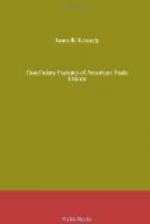---------------------------------------------
CHAPTER III.
SICK BENEFITS.
Second in importance among the systems of benevolent relief maintained by American trade unions is the sick benefit paid to members who are prevented by illness from working. Historically, the sick benefit was probably the earliest beneficiary feature inaugurated by local trade unions, but, for several reasons, its adoption by the national unions was delayed. At the present time two systems of sick benefits can be found among American trade unions. In some unions this benefit is paid from the funds of the local union but is subject to the general supervision of the national organizations. In other unions it is disbursed from the national treasury and is immediately controlled by the national officials.
Of the one hundred and seventeen unions allied with the American Federation of Labor in 1904, twenty-eight reported payment of sick benefits.[120] They were as follows: Bakers and Confectioners, Barbers, Bill Posters, Boot and Shoe Workers, Brotherhood of Carpenters and Joiners, Amalgamated Carpenters,[121] Cigar Makers, Compressed Air Workers, Foundry Employees, Freight Handlers, Fur Workers, Glass Snappers, Hotel and Restaurant Employees, Jewelry Workers, Leather Workers on Horse Goods, Machine Printers and Color Mixers, Machinists, Mattress, Spring and Bed Workers, Iron Molders, Oil and Gas Well Workers, Piano and Organ Workers, Plumbers, Print Cutters, Street and Electric Railway Employees, Tile Layers, Tobacco Workers, Travellers’ Goods and Leather Novelty Workers, Wire Weavers. All of these, with a few exceptions, such as the Machinists and the American Wire Weavers, pay sick benefits from the national treasury.
[Footnote 120: Proceedings of the Twenty-fourth Annual Convention (Washington, 1904), p. 46.]
[Footnote 121: An English union with branches in the United States, with a voting strength of fifty in the American Federation of Labor, representing about four thousand members.]
The following table contains a list of the principal organizations that pay national sick benefits, arranged in the order of the introduction of the benefit:




